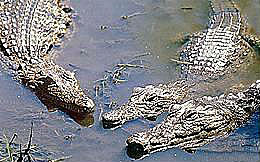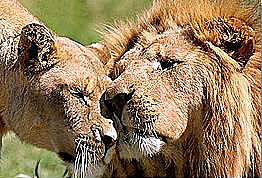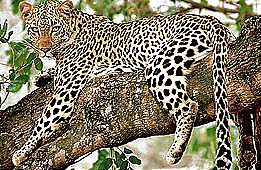 Framed by glowing sunsets and a bountiful
canopy of stars, lies the Kruger National Park. The park, rich in
biodiversity, was established in 1898 and stretches for 350km (approx
140 miles – within the park itself the road network measures in at
about 1300 miles) from the south to north along the Mozambican border
before meeting up with the Zimbabwean border. A paradise for the
wildlife enthusiast with close to 150 mammals to be on the look-out
for, amongst them six cat species, the park also has more than 500
species of birds and over 300 species of trees for the visitor to
identify. With its subtropical climate, the large habitat variety and a
surface area of 19 633km², the park is home to a spectacular
array of fauna and flora and is undoubtedly the world leader in dynamic
environmental management techniques and policies based on experience
gained over more than a century.
Framed by glowing sunsets and a bountiful
canopy of stars, lies the Kruger National Park. The park, rich in
biodiversity, was established in 1898 and stretches for 350km (approx
140 miles – within the park itself the road network measures in at
about 1300 miles) from the south to north along the Mozambican border
before meeting up with the Zimbabwean border. A paradise for the
wildlife enthusiast with close to 150 mammals to be on the look-out
for, amongst them six cat species, the park also has more than 500
species of birds and over 300 species of trees for the visitor to
identify. With its subtropical climate, the large habitat variety and a
surface area of 19 633km², the park is home to a spectacular
array of fauna and flora and is undoubtedly the world leader in dynamic
environmental management techniques and policies based on experience
gained over more than a century.
 Most
national parks also offer organised night drives or early morning
drives in park vehicles with guides, but they have to stay on the road
and take place at set times, so many people hire a car themselves to
explore the parks on their own. Most parks have rest camps, and
— depending on the park – a range of accommodation,
from camps and huts to bungalows and guest houses. Most accommodation
is equipped with self-catering facilities, although many camps do have
shops, and some have restaurants.
Most
national parks also offer organised night drives or early morning
drives in park vehicles with guides, but they have to stay on the road
and take place at set times, so many people hire a car themselves to
explore the parks on their own. Most parks have rest camps, and
— depending on the park – a range of accommodation,
from camps and huts to bungalows and guest houses. Most accommodation
is equipped with self-catering facilities, although many camps do have
shops, and some have restaurants.
In the last 20 years most of the fences have been removed between the private reserves and South Africa’s Kruger National Park, allowing game to roam freely. The most famous of the parks is Sabi Sands where you can find well known lodges such as Londolozi, Singita and Mala Mala. The Timbavati area is slightly further north and is well known for its large populations of elephant and buffalo.
When to Go
Between October and March, when summer rains transform the dry landscape into a flowering paradise, the park is alive with baby buck and migratory birds, but at the same time temperatures can hit over 105°F (40°C), dropping to 68°F (20°C) in the evenings. The foliage can often hide game, and this is when the risk of malaria is at its highest so you are advised to take a course of anti-malaria drugs.
 In
the winter, when water is scarce and the plant life dies back, the
animals are easier to spot, especially at water holes and riverbeds.
This is the most popular season, so be prepared to share your safari
with other motorists. The days are warm, but temperatures can drop
close to freezing at night, and units are not heated. Try to avoid
going during the school holidays, particularly in winter, when the park
is packed to capacity.
In
the winter, when water is scarce and the plant life dies back, the
animals are easier to spot, especially at water holes and riverbeds.
This is the most popular season, so be prepared to share your safari
with other motorists. The days are warm, but temperatures can drop
close to freezing at night, and units are not heated. Try to avoid
going during the school holidays, particularly in winter, when the park
is packed to capacity.
Driving
Unlike some private game reserves where rangers are permitted to drive off road, at Kruger you must drives on roads. The speed limit is 50 kmph on paved roads; 40 kmph on gravel roads; 20 kmph in the rest camps (30, 25, and 15 mph, respectively). There are speed traps! You should always stay in your vehicle unless you’re at a designated picnic site.
Safety
Under no circumstances should you leave your vehicle unless at a designated site; one story goes that a local ranger left his game drive to “relieve” himself didn’t survive to do up his zipper, so make sure to visit the bathroom before leaving your rest camp.
Entrance and Admission
The entrance gates open from January to February from 5:30am to 6:30pm; March from 5:30am to 6pm; April from 6am to 6pm; May to July 6am to 5:30pm; August to September 6am to 6pm; October from 5:30am to 6pm; and November to December from 5:30am to 6:30pm.
Admission to the Kruger Park costs R30 ($4.75) per person and R24 ($3) per vehicle; children ages 2 to 15 R15 ($2).
For the Rest Camps, the gates follow the same hours except in the summer months (Nov-Jan) when they open an hour earlier (that is, 4:30am). Camps are fenced off to protect residents from animals. If you’re changing rest camps, try not to ensure that you get to your new camp before its gates close. Operating hours for camp receptions are from 8am to 5:30pm; for shops from 8am to 1/2 hour after camp gates close; for restaurants from 7 to 9am, 12 to 2pm, and 6 to 9pm. There are petrol stations at every rest camp, but you can only pay in cash.
The highest risk of malaria is between October and May,
Getting There
There are nine entrance gates, around a 5- to 6-hour drive from Johannesburg or Pretoria. The closest gate, Malelane, is 428km (265 miles) from Johannesburg, while Punda Maria (the farthest) lies 581km (360 miles) northeast. The southern gates: Malelane, Crocodile Bridge, Numbi, Phabeni, and Paul Kruger. The central gates: Orpen and Phalaborwa. The northern gates: Punda Maria and Parfuri. Allow sufficient travelling time to the park; entrance-gate hours are strictly adhered to. Note that officials recommend using the new Phabeni Gate from safety and ease of access point of view.
To get to the Kruger park by air, there are three airports in the Kruger vicinity: Kruger-Mpumalanga International Airport (near White River and Hazyview, southern Kruger), Eastgate Airport (Hoedspruit, southern/central Kruger), and the Kruger Park Gateway Airport (Phalaborwa, central Kruger). There are daily flights from Cape Town on SA Express (www.saexpress.co.za) to Hoedspruit’s Eastgate Airport. SA Airlink (www.saairlink.co.za) flies daily to the relatively nearby Kruger-Mpumalanga International — as does Nationwide (www.flynationwide.co.za), but you’ll have to stop in Johannesburg for at least 20 minutes to pick up passengers. From Johannesburg, SA Express flies daily to Hoedspruit’s Eastgate Airport. SA Airlink and Nationwide fly daily to Kruger-Mpumalanga International. SA Airlink also flies daily from Johannesburg into Kruger Park Gateway Airport. From Durban: SA Airlink flies Sunday through Friday to Kruger-Mpumalanga airport.
For more information contact Dewald Bodenstein at info@stylishtravel.co.za or visit the official webpage www.krugerpark.co.za
